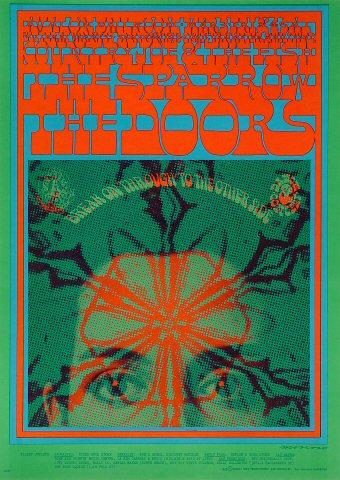The Doors Poster

Image may not exactly match item shipped.
The 1st printing shows the ticket outlet information in green, and there is a tiny black dot in the top left portion of the second "R" in "Sparrow". This original printing pre-dates the concert and measures 14 1/16" x 19 15/16".
The 2nd printing A displays the ticket outlet information in white and has no dot in the "R" of "Sparrow". It measures 14" x 19 15/16" and was printed after the concert.
2nd printing B omits the ticket outlet information altogether, and has an obvious printing flaw which runs horizontally across most of the letters in the word "Sparrow". It measures 14" x 19 15/16" and was also printed after the concert.
The 3rd printing is identical to the 1st printing except the dot in the "R" of "Sparrow" is missing. It measures 14 1/16" x 19 15/16" and was printed after the concert.
The post-concert 4th printing A replaces the ticket outlet strip in the bottom margin with "Printed by Offset in Three Colors on International Paper's Springhill Whitetag, Basis 100." A short essay about the printing technique and the life of Victor Moscoso appears on the back, and "No. 50-1" is in the lower left corner. It measures 14 1/16" x 20 1/16".
The post-concert 4th printing B also has the "Printed by Offset" credit in the bottom margin, but omits the "No. 50-1" of the A version. It measures 14 1/16" x 20 1/16".
Born in Spain, Victor Moscoso was the first of the rock poster artists with serious academic training and experience. At the Avalon Ballroom in San Francisco, Moscoso saw rock posters and decided that he could "make some money doing posters for those guys." In 1966, he began designing posters for the Avalon Ballroom; and under his own imprint, Neon Rose, a series for the Matrix, a San Francisco nightclub. Moscoso's style is most notable for its visual intensity, which was obtained by manipulating form and color to create optical effects. He used clashing, vibrating colors and deliberately illegible psychedelic lettering to demand attention.